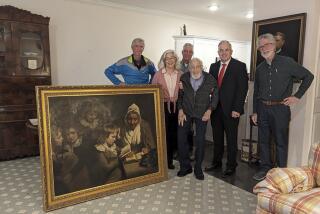David Hockney brings color back home
He may have traded Southern California warmth for the gun-metal skies and windy damp of his native England, but this is surely David Hockney’s moment in the sun.
His compatriots are busy hailing him as undoubtedly Britain’s greatest living painter now that his friend Lucian Freud has died. Queen Elizabeth II just appointed him to the Order of Merit, an honor restricted to 24 Britons at any one time for their contributions to the arts and sciences.
In the pages of the Guardian — the left-wing paper to which Hockney regularly dashes off harrumphing letters to the editor — a fashion writer felt moved to confess that the artist, a “brilliantly intentional nerd,” was “my all-time style hero.”
All the adulation is gratifying to Hockney, who has been living and working in Britain more or less full-time for the last few years. Which raises the question: Has he given up Los Angeles, the city he’s called home for more than three decades and that considers him an adopted son?
Hockney waves away the notion with one of the cigarettes that seem permanently lodged between his fingers.
“I haven’t really left L.A. When people in Hollywood ask what I’m doing, I say I’m on location,” he says with a chuckle in his Kensington studio. “That’s a term they understand. It’s just taking a lot longer than I expected.”
The reason for the extended absence can now be seen on the walls of London’s prestigious Royal Academy of Arts. Late last month, “David Hockney: A Bigger Picture” opened to rapturous reviews and massive ticket sales, making it the first blockbuster art show of 2012 in the British capital.
The exhibition marks a late-in-life return to big landscape painting for an artist many identify with indolent scenes of swimming pools and slender young men. Its title even riffs on the most well-known of those paintings, “A Bigger Splash.”
The scale of the new show is gargantuan, both in the number of works on display (more than 150) and the sheer size of some of them (the largest is 12 feet by 32 feet).
Remarkably, however, this is no nostalgic retrospective, though a handful of works date as far as the 1950s and ‘60s. Most of the paintings and drawings were created in the last several years, including a staggering 52-part series from 2011, in a burst of productivity that can be attributed to Hockney’s boundless enthusiasm and energy at age 74, his ever-present iPad and the cavernous room in the gallery where the entire set hangs.
California influence
The exhibition plants him firmly back in the East Yorkshire of his youth, a region in northern England of unassuming chalk hills and leafy lanes that he used to cycle around as a boy and later as a young man who took on summer farming jobs.
Though some Britons dismiss East Yorkshire as drab by comparison with the romantic heather and moors of Bronte Country to the west, in Hockney’s hands the area is a riot of color — deep reds, shocking purples, splashy yellows and multiple shades of green in the trees, fields, paths and hawthorn bushes. The paintings and poster-size prints from iPad drawings evoke Van Gogh, Seurat, Rousseau and even Hockney himself from his earlier, sun-drenched period.
“These are landscapes of Yorkshire painted by somebody from Yorkshire but who lived in California for 30 years. It’s bound to have an effect,” says Hockney, who still speaks with a Yorkshire accent. “People said, ‘You brought California color there.’ I said, ‘Not quite,’ but [it’s] certainly made me look at color” differently.
“West Yorkshire is quite dramatic and beautiful, the crags and things,” he adds. “East Yorkshire, to the uninitiated, just looks like a lot of little hills. But it does have these marvelous valleys that were caused by glaciers, not rivers. So it is unusual.”
Hockney began returning more often to Yorkshire in the 1990s, usually to visit his mother, who died in 1999. A friend who was terminally ill encouraged him to turn his brushes to capturing the local surroundings, which he did at first with paintings based on memories of the area, some from his boyhood.
In 2007, Hockney produced “Bigger Trees Near Warter,” a monumental oil spread across 50 canvases that was displayed at the Royal Academy before he gave it to the Tate Gallery. The academy eventually asked Hockney if he would be interested in mounting an exhibition in 2011 devoted to his Yorkshire landscapes, a project he eagerly accepted, though he insisted it wait till 2012 so that he could have more time to observe and prepare.
“When the RA asked me to do this exhibition, I said, ‘I need three more springs.’ That’s three years; you can’t speed them up,” he says. “That’s the big difference with L.A. You do have the seasons in L.A., but you have to be a botanist and know what flowers come out [then]. It doesn’t hit you on the head as it does here....
“If the RA hadn’t come along, I would probably have done a few more and maybe just gone back to L.A.,” he says. “But because they offered what are splendid rooms, right in the middle of London, I thought, ‘One should use this opportunity.’ Of course you should. And it’s a big stimulant.”
He set up residence and an immense studio, a converted industrial workspace, in the seaside village of Bridlington, about 75 miles from where he was born in the city of Bradford. In search of different angles, plays of light and states of verdure, Hockney roused his staff at unpredictable hours and worked through all four seasons, at times painting outdoors on an easel while gazing at the view, at others hurriedly sketching from memory onto his iPad as he sat in the car to escape the harsh winter cold.
An enthusiastic early adopter of new technology, he sent his iPad drawings electronically to L.A., where another team of assistants printed them.
“We had to get special software to do it. Otherwise, they pixilate,” Hockney says. “It’s very new, and very, very different.”
Aging colorfully
It’s tempting to see his Yorkshire paintings — with their attention to the changing seasons, the cycle of life and death — as a natural progression for a septuagenarian artist, a suggestion he doesn’t deny. Hockney likes to call painting “an old man’s art,” and concedes that he probably wouldn’t, or perhaps couldn’t, have made these works as a younger artist.
Their super-saturated colors may be directly related to his advancing age and his growing deafness, a subject he speaks of at length. (“I do do a lot of talking, because it saves me listening.”) Loss of hearing, he thinks, may have heightened his already-sharp visual awareness and the delight he receives through the eyes.
And exploring a single subject so long and so deeply requires an older person’s patience and perspective. It proved an exhilarating, not exhausting, experience, Hockney says, comparable to what he believes Monet must have felt with “Les Nympheas,” the vast water-lily paintings that grace Le Musee de l’Orangerie in Paris.
“I will point out that the chain-smoking Monet didn’t begin the ‘Nympheas’ until he was in his 70s. It took 10 years. Then he died,” Hockney says. “But it must have given him, the moment he saw this project, a very powerful force in him that kept him alive.”
The new exhibition includes Hockney’s recent reworkings of Claude Lorrain’s “The Sermon on the Mount” and giant iPad drawings made in October of Yosemite, which are crowded into a small room at the end — symbolic, perhaps, of California’s relegation to the background in Hockney’s life at the moment.
The famous 1986 photo collage “Pearblossom Highway,” on loan from the Getty Museum, hangs on one wall; “Mulholland Drive,” held by the Los Angeles County Museum of Art, makes an appearance as well, but only as a full-sized photographic replica. LACMA was leery of rolling up the huge painting for a potentially stressful journey to London; Hockney says he understood. “It’s not the best thing to do.... I wouldn’t like it damaged.”
As well-known as some of the other works are, it’s the lavish treatment of the northern English countryside that has generated much of the excitement in Britain over the show.
“Absolutely amazing,” Rachel Malka, 49, said recently as she stood in the room housing the 52-part series, titled “The Arrival of Spring in Woldgate, East Yorkshire in 2011 (twenty-eleven).” “It makes you want to go up there and have a look. You’d recognize it instantly — his attention to detail is phenomenal.”
From London, the exhibition will move to Bilbao, Spain, and then Cologne, Germany, where it’s scheduled to close a year from now. There is no word whether it might travel to the U.S.
Hockney will, though: He plans to drop in on L.A. this month for the Oscars and the parties. He’s not done yet with working in England, and he still holds only a green card for U.S. residency after all these years (he’s not “respectable” enough for American citizenship, he says), but Southern California will always beckon.
“I have a house in L.A., since 1979, and I have no intention of getting rid of it,” Hockney says. “California is always in my mind.
“I’ve lived in L.A. far longer than London. I know it better.... It is full of mad, creative people.”
Minus one, for now. But he’ll be back.
More to Read
The biggest entertainment stories
Get our big stories about Hollywood, film, television, music, arts, culture and more right in your inbox as soon as they publish.
You may occasionally receive promotional content from the Los Angeles Times.







